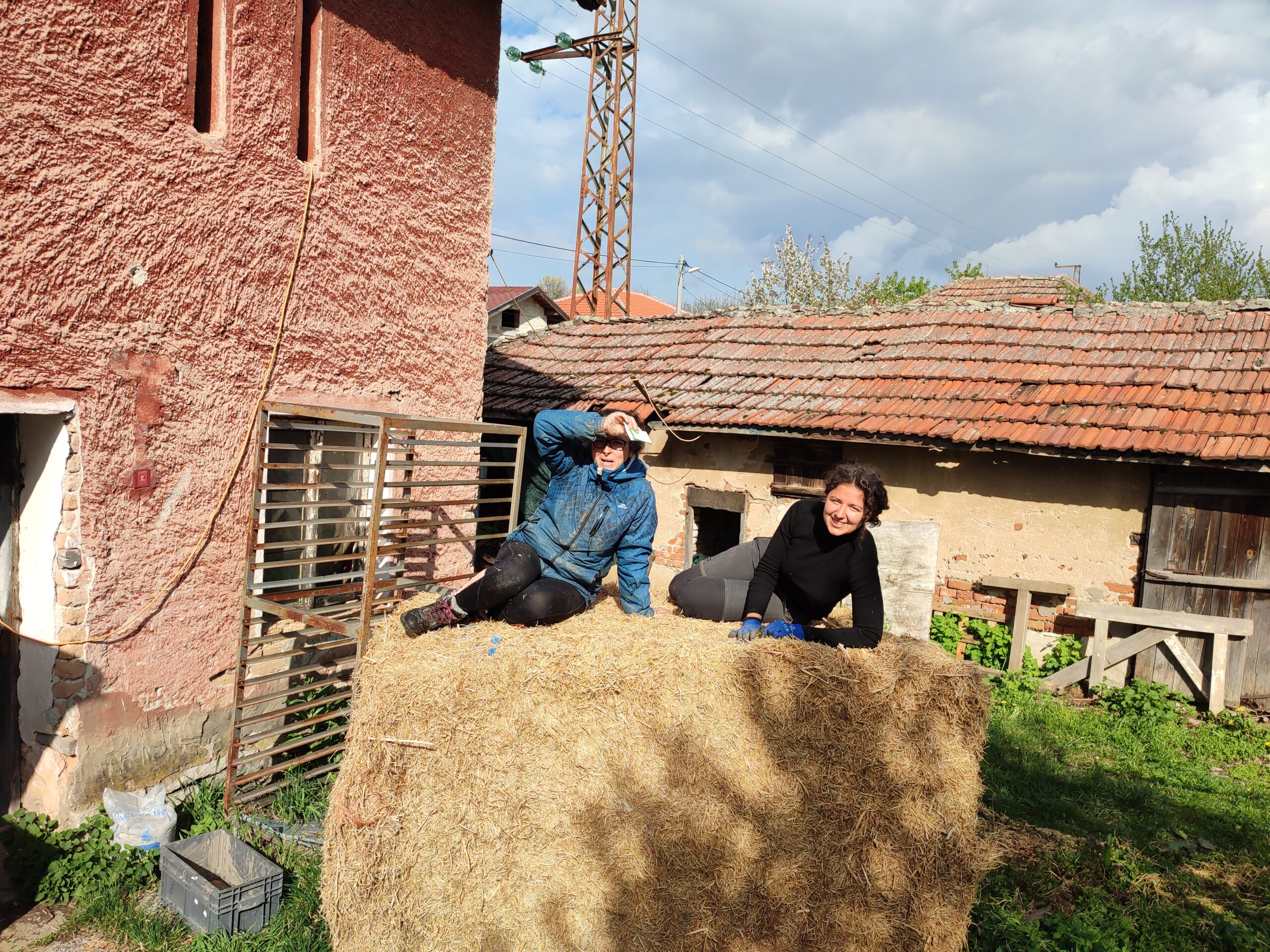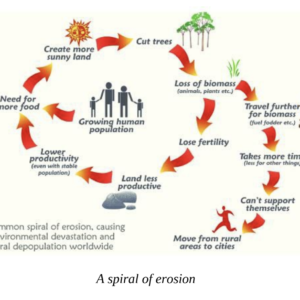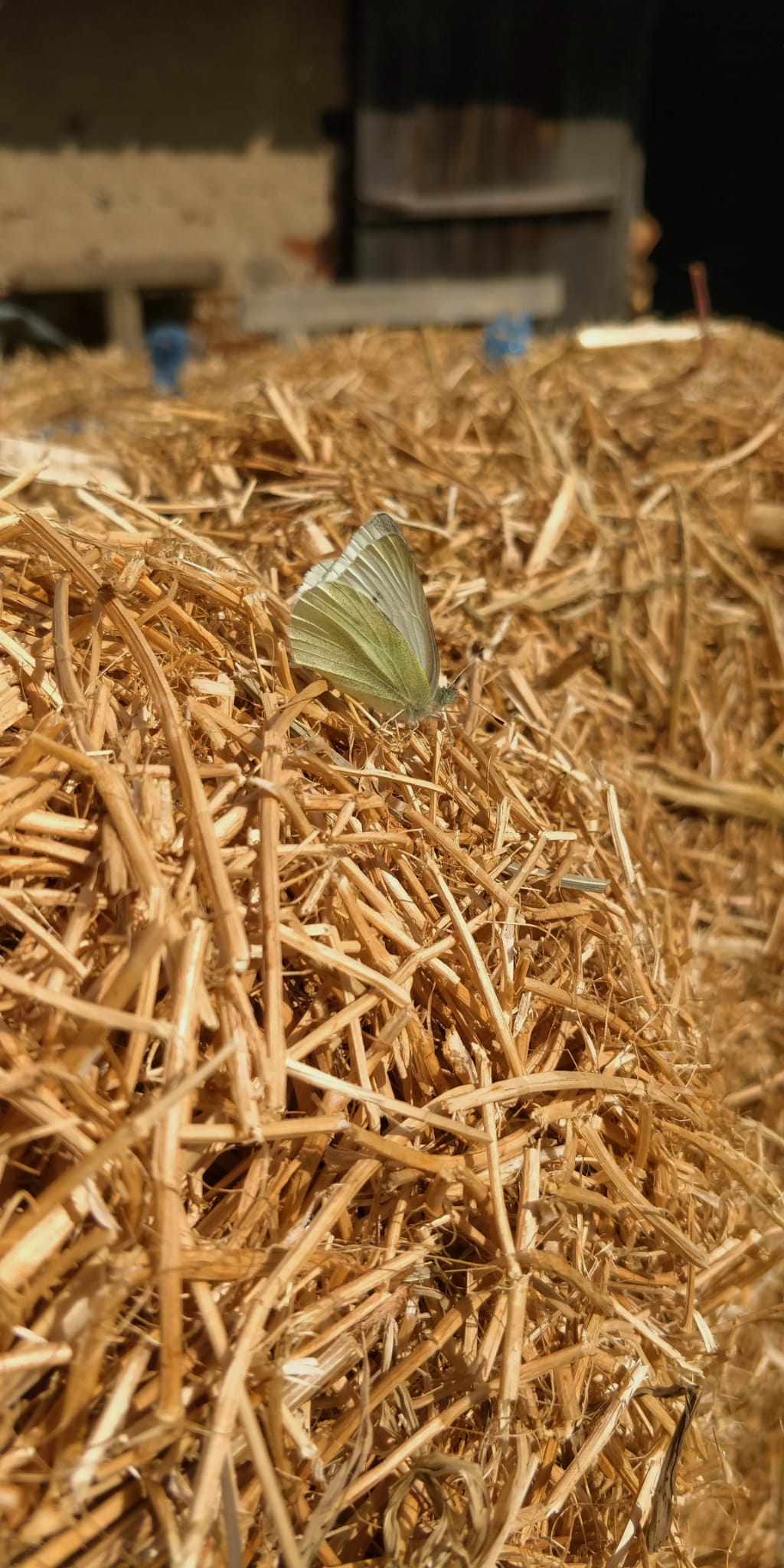Anastasja:
Hello all!
This week was quite short because we had Easter Monday off, and Peter and I were still in Plovdiv. When we got back to Todorovo we started fixing the irrigation in the Red house garden and the Sunny yard, replacing or fixing leaking pipes and tubes. We cleared out and organized some storage rooms, getting really dusty but satisfied in the process. And we tried to get the bugs in the Greenhouse under control (Francois can tell you more about that).
Then the rest of the week we were occupied by two main activities which have a lot in common:
- We made paths between the beds by putting cardboard and then a thick layer of sawdust on top. Like this weeds don’t get enough sunlight and are also physically blocked, so the paths stay clear of weeds and the weeds don’t grow into the beds.
- We applied straw to cover the strawberry beds. The straw also blocks weeds and retains moisture so our strawberries can thrive.
What do these two activities have in common? Making paths and covering beds? Probably you already guessed it from the blog title… They are both termed as… drum roll… mulching!
Have you heard of it? To be honest, for me mulching was quite the discovery because it is not such a common practice where I come from. I myself spent a lot of time weeding in my mother’s garden. Indeed, most gardens you see around my region are constantly being cleared of weeds and show a lot of bare soil.
Mulching is one of permaculture gardeners’ favorite tools because it is a relatively simple and great way to suppress weeds, conserve moisture, and enhance soil, all at the same time. If done the right way, mulching can improve soil health and the growth of your plants. Moreover, it helps fend off soil erosion by not leaving the soil exposed to winds and water. It avoids water runoff because it retains the water and slows down water flow on a slope, so that water can slowly seep into the soil.There’s so much more to say about mulching, but let me tell you about a few different types of mulch and their pros and cons:
- Hay: cut and dried grass
- Pro: It adds a lot of nutrients to the soil, retains moisture, suppresses weeds, and cools soil.
- Con: It can contain weed seeds, so you should get hay from unripened plants, and if you have chickens, let them run through the hay to pick out any seeds.
- Straw: dry stalks of grains and cereals
- Pro: retains moisture, cools soil, suppresses weeds.
- Cons: contains less nutrients than hay.
With both hay and straw you should check whether it has been sprayed with anything. Use both strategically, as they cool the soil; so if you live in a cooler area, rather use them from late spring/early summer onwards.
- Cover crops or living mulches: plants that cover the soil (e.g. clover, creeping thyme, camomile…) – I really love these!
- Pro: enhance soil by adding nutrients and decomposing organic matter, suppress other weeds.
- Con: you have to keep your cover crops in check, or they will become weeds.
- Research which cover crops work best in your area, when to plant them, and if you want to use them for crop rotation also check with which plants they work best together.
- Cardboard: best used underneath other mulches
- Pro: suppresses weeds really well, retains moisture.
- Con: blows away and should be weighted down.
- Avoid inks and waxes, remove all plastic and other materials which you don’t want in your soil.
- Raw wool:
- Pro: retains moisture, suppresses weeds, adds nutrients to the soil, may deter slugs, keeps soil cool in the summer and warm in the fall.
- Cons: not ideal for direct seeding, breaks down slowly (which is also a pro because you can use it repeatedly and it slowly releases nutrients into the soil).
Other examples of mulches are sawdust and wood chips (used mainly on paths), compost, leaves… and many more. Always opt for the mulch you have most readily available in your area and which works best for your type of garden. At Venets we mainly use straw, raw wool, cardboard, and compost for the beds, and cardboard and sawdust for the paths. However, which mulches we use varies because we always use whatever is most convenient and often materials which others would discard.
Did I already convert you to mulching? If not, here is a video that will definitely get you hooked:
And if that was not enough, here is a video by permaculture guru Geoff Lawton who talks about how mulch can work its magic even in drylands:
Happy mulching,
Anastasja
François:
Dear beautiful permaculturists,
As spring is setting in and temperatures are getting warmer, perfect conditions are united for all kind of pests to thrive. We are ourselves witnessing the return of our little friends in our gardens. Some of them are actually very profitable for us (I’ll cover this topic in another post, *wink wink*), but some other are really just eating our crops, which we obviously want to avoid. This, in turn, opens the very touchy question of how to repel them the most effectively with using the most natural methods (that is, not Roundup).
Fortunately, such methods do exist, and I will cover some of them in this post. Keep in mind, however and as always, that some of them might not be appropriate for your garden or your needs, and that you will have to experiment them before forging an opinion on this. Without further ado, let’s get starting!
Before doing anything
If you see something on your crops, the first step is to identify it, and make sure whether it’s a good or a bad insect. Then you’ll have to monitor it, that is observing its population and whether it’s growing or not. Finally, you will have to make a decision based on the previous steps: is it worth doing something if there’s only one ant? What is the threshold of action? Sometimes, just pulling the pest away might be the best solution.
Companion planting
Some plants have the natural property of repelling some insects, notably by the molecules they excrete. For example, basil will repel flies, mosquitoes, carrot flies and white flies, whereas geranium will repel corn earworm and small white. You can more of them on the Permaculture Research Institute’s website. Thus, knowing a particular plant’s pests, you might want to grow the aforementioned plants next to it. You can even grow so-called sacrificial plants, that you will sacrifice to pests for the greater good of saving some others.
Plant-based products
Spearmint is a good repellent for many common insects: you can display it in sachets with garlic, or spray it mixed with oil. Speaking of garlic, many insects abhor it. If you are brave enough, you can also make a spray out of it, as well as out of basil for indoor flying pests. Finally, for tea-lovers, a wormwood (Artemisia absinthium) infusion is a good product against fleas, flies and slugs.
Animals and other bugs
If you have animals in your garden, or if you want to have some, they can be your best allies fighting against pests. Some, for example, recommend to build bird houses and to place them regularly in your yard. Having chickens or ducks is also a great solution. Ladybugs, on the other hand, are “good” bugs that will eat the bad ones.
Organic sprays
Sometimes there is not much more solution than using pesticides… when you do however, please make sure that the one you’re using is organic, and doesn’t harm anything else than the pests.
Integrated Pest Management (IPM, or IPC for Control)
The UN’s FAO defines IPM as “the careful consideration of all available pest control techniques and subsequent integration of appropriate measures that discourage the development of pest populations and keep pesticides and other interventions to levels that are economically justified and reduce or minimize risks to human health and the environment”. IPC aims to create on the long-term an ecosystem that is, in itself, pest-free. The idea is then to address the very conditions that led to pests to thrive in the first place. For example, pests attack more easily weaker plants, such as over- or underwatered plants, plants growing in bad soil, etc. Another example: some plants (or rotten fruits) will attract bad bugs! IPM is a very wide topic, and as such I might dive into it more in detail in a future post -who knows?
Today Misha and I did a workshop on landscaping and the combination of landscape design and permaculture-design. For this reason she introduced me to a paper model used for PDC courses to highlight these things. It uses the isolines and it’s a session, a mast from our PDS course, where they observe the key lines of the terrain and discuss a lot of things including water capture on the terrain, a particularly important topic now past the drying of the land past climate change and the multiple fires. We also went through a whole PDC-course in Sofia, so that I could gain immensely important knowledge that could be highly beneficial for my future projects and work. I also examined different schooling materials in order to deepen my knowledge on permaculture. For that Misha had accumulated a set of knowledge documents on our shared google drive. Amongst them is the famous and influential work of Aranya: “Permaculture Design – a step-by-step guide”.
I particularly found this graph to be interesting, as it is my goal to work on project sites on the African continent in the future. The graph precisely describes the degradation of land through erosion. My goal is to engage in activities including reforestation and neutralization and reparation of damaged lands. The piece of knowledge received will hopefully serve me in these aspirations. The opportunity to receive a permaculture design certificate made me very aware of our role in the environment and how complex and diverse ecosystem can be and how vastly empowering permaculture is in that sense.
This is not a pest 😉 (Photo credit: François Dupé)
Sources:
- Permaculture Research Institute – Based Insect Repellents
- Gardener Scott – Garden Insect Control (IMP)
- Self Sufficient Me – 10 Organic Ways to Control Pests in the Garden
Happy repelling!
François




